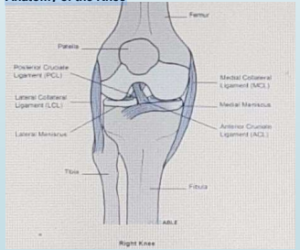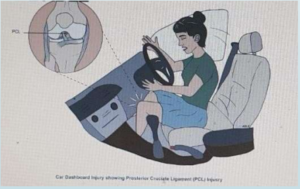A. Torn medial meniscus – Explanation
This is a classic picture of a common sports injury. The player jumps up and lands on a
slightly twisted knee hence giving rise to a medial meniscus tear.
slightly twisted knee hence giving rise to a medial meniscus tear.
He could very well also have an anterior cruciate ligament injury as meniscal tears are
often associated with ACL injury.
If this question had medial collateral ligament tear as a choice, then you would pick that.
If you remember the mechanism of injury for knee trauma, then you will never get a
knee question wrong in the exam.
KNEE INJURIES, MECHANISM OF INJURY
For knee injuries, remember a few things about the mechanism of injury
Anatomy of the Knee

Medial collateral ligament
- Direct blow to the lateral side of the knee or a twisting injury. Often occurs along
with meniscal tears

Lateral collateral ligament
- Direct blow to the medial side of the knee or a runner twisting to the direction of the
planted foot (twisting inwards)

Anterior cruciate ligament
- Deceleration injury or when the athlete lands hard on the leg and quickly pivots to
the opposite direction.
- ACL tears usually have a stem where the foot is fixed on the ground when a
rotational force is applied which is followed by a “pop” sound. They would complain
that the knee “gives way”

Posterior cruciate ligament
- Hyperflexion injury or a fall onto a flexed knee if the knee hits the dashbord of a car
during a road traffic accident - Look for a history of direct impact on the shin (specifically the proximal tibia) when
the knee is bent

Meniscal tears
- Twisting or pivoting, a popping sensation heard at time of injury
- Often associated with ACL injury
